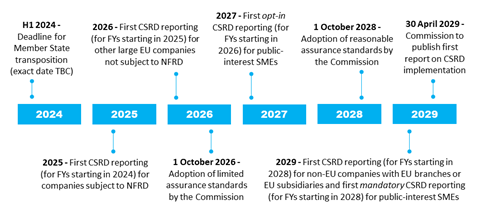By Hazell Ransome, Senior Policy Analyst, EU, PRI; and Benjamin Taylor, Analyst, Driving Meaningful Data, PRI


Corporate sustainability reporting – it is essential for responsible investment and the past year has seen a whirlwind of policy promises and actions on the topic.
For example, the International Sustainability Standards Board (ISSB) consulted on draft standards proposing a global baseline for sustainability-related financial disclosures; the US Securities and Exchange Commission consulted on mandatory climate reporting; and Japan’s Financial Services Agency recommended including sustainability information in annual statutory financial reporting.
The EU joins this global surge, with its Corporate Sustainability Reporting Directive (CSRD) reaching provisional political agreement on 21 June.
Corporate sustainability reporting that delivers consistent and comparable data is fundamental to building a sustainable financial system and supporting responsible investors, as outlined in our policy toolkit. So, the question is, will the CSRD help investors access the data they need and what can PRI signatories do to ensure that it does?
What does the CSRD mean for investors?
The CSRD revises the Non-Financial Reporting Directive (NFRD) and the Accounting Directive, aiming to ensure that sustainability data is comparable, relevant, and reliable.
It requires companies of a certain size operating in the EU to report sustainability information which, for the first time, will be specified through the European Sustainability Reporting Standards (ESRS). These standards aim to illustrate companies’ impacts on sustainability matters (impact materiality), and how sustainability matters affect companies’ development, performance and position (financial materiality).
The CSRD determines which companies must report, on what topics, where and when – offering useful information to investors and other capital providers, civil society actors, business partners, and other stakeholders. The ESRS – which we discuss later in this article – will clarify the information to be disclosed for each sustainability issue and how this should be reported.
The PRI welcomes the agreed CSRD – it will create a significant shift in corporate sustainability reporting that will be hugely beneficial to investors.
It addresses several points that we raised in our investor statement of support and position paper – on scope, location and assurance – when responding to the European Commission’s proposal last year:
- Scope
The scope of companies required to report under the CSRD will be significantly bigger than under the NFRD, which was limited to large, listed EU companies with 500+ employees. The CSRD will place reporting requirements on large, listed and non-listed, EU companies[1]; listed EU SMEs[2]; and non-EU companies with at least one EU subsidiary/branch[3].
- Location
Unlike the NFRD, the CSRD specifies that companies’ sustainability information must be clearly identifiable within a dedicated section of their management reports, in a digital and machine-readable format.
- Assurance
For the first time, it will be mandatory for companies to have their sustainability information assured by qualified third parties, consistent with soon-to-be-adopted European Commission standards. This will initially be limited, focusing on ESRS compliance and how information is identified and presented. By 1 October 2028, subject to the outcome of an impact study, the Commission may adopt assurance standards that would involve a more extensive assessment.
That said, investors will not have access to this sustainability data immediately, so implementing the Sustainable Finance Disclosure Regulation (SFDR) and EU taxonomy disclosures remains challenging in the short term.
As shown in the timeline below, large EU companies not already subject to the NFRD will only need to start reporting in 2026. Small and medium EU companies or those headquartered elsewhere will only have to start reporting in 2029.
Investors can mitigate these disclosure challenges, as outlined in our report, Implementing the EU taxonomy.
Figure 1: Timeline of the EU’s corporate sustainability reporting regulations as they come into force.

Now, let’s look at the European sustainability reporting standards.
How will the draft ESRS support investors?
The European Financial Reporting Advisory Group (EFRAG) is tasked with providing draft ESRS and related technical advice to the European Commission before it adopts any finalised standards.
In August 2022, EFRAG concluded its consultation on the first set of draft standards. These contain requirements applicable to all sustainability issues, and issue-specific requirements (see our dedicated briefing note).
Reporting would capture forward-looking and retrospective information – qualitative and quantitative – across short-, medium-, and long-term time horizons. Reporting boundaries would include the upstream/downstream value chain as needed to capture material sustainability matters.
In the consultation response submitted last month, we welcomed the draft standards as a significant step towards providing investors with the sustainability information needed for making decisions across a necessary range of sustainability issues.
We also made several recommendations, including that EFRAG:
- provides additional guidance and requirements on how to assess the materiality of – and improve the connectivity of reporting on – sustainability risks, opportunities, and impacts;
- considers the information investors need to meet their reporting obligations, such as SFDR and the EU taxonomy, as ESRS are developed;
- improves the technical alignment between ESRS and ISSB draft standards (to reflect their similarities in content) and includes a TCFD-aligned presentation option for sustainability reports; and
- enhances reporting on exposure to physical risks, compliance with the UN Guiding Principles on Business and Human Rights, and political engagement/lobbying/advocacy.
What’s next and how can investors ensure the best outcome?
Although the CSRD is now finalised, the ESRS are still under development. EFRAG is assessing consultation feedback before it submits revised ESRS to the European Commission in November this year.
The Commission will then take over, holding another consultation before adopting the first set of ESRS into legislation by June 2023. It aims to adopt a second set, to include sector- and SME-specific standards, by June 2024.
The PRI will continue to engage EFRAG, the European Commission, and other relevant stakeholders on the ESRS, and keep signatories updated on ESRS-related developments.
We also encourage investors to engage and provide us with feedback on the draft standards, as this will help to ensure that disclosures under the CSRD meet the requirements arising from their investment strategies and own regulatory obligations.
This blog is written by PRI staff members and guest contributors. Our goal is to contribute to the broader debate around topical issues and to help showcase some of our research and other work that we undertake in support of our signatories. Please note that although you can expect to find some posts here that broadly accord with the PRI’s official views, the blog authors write in their individual capacity and there is no “house view”. Nor do the views and opinions expressed on this blog constitute financial or other professional advice. If you have any questions, please contact us at [email protected].
References
[1] Large is defined as exceeding, on the closing date of its balance sheet, two of the following three thresholds: 250 employees; €20 million in balance sheet total; €40 million in net turnover.
[2] Small/medium is defined as below the large threshold but exceeding, on the closing date of its balance sheet, at least two of the three following criteria: 10 employees; €350,000 in balance sheet total; €700,000 in net turnover.
[3] The non-EU parent company must have at least €150 million turnover in the EU, while its EU-listed subsidiary must be large (see above) and/or its EU branch must have at least €40 million turnover in the EU.












